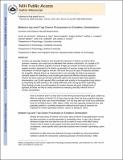| dc.contributor.author | Ochsner, Kevin N. | |
| dc.contributor.author | Ray, Rebecca R. | |
| dc.contributor.author | Hughes, Brent | |
| dc.contributor.author | McRae, Kateri | |
| dc.contributor.author | Cooper, Jeffrey C. | |
| dc.contributor.author | Weber, Jochen | |
| dc.contributor.author | Gross, James J. | |
| dc.contributor.author | Gabrieli, John D. E. | |
| dc.date.accessioned | 2012-03-30T21:20:33Z | |
| dc.date.available | 2012-03-30T21:20:33Z | |
| dc.date.issued | 2009-11 | |
| dc.identifier.issn | 0956-7976 | |
| dc.identifier.issn | 1467-9280 | |
| dc.identifier.uri | http://hdl.handle.net/1721.1/69910 | |
| dc.description.abstract | Emotions are generally thought to arise through the interaction of bottom-up and top-down processes. However, prior work has not delineated their relative contributions. In a sample of 20 females, we used functional magnetic resonance imaging to compare the neural correlates of negative emotions generated by the bottom-up perception of aversive images and by the top-down interpretation of neutral images as aversive. We found that (a) both types of responses activated the amygdala, although bottom-up responses did so more strongly; (b) bottom-up responses activated systems for attending to and encoding perceptual and affective stimulus properties, whereas top-down responses activated prefrontal regions that represent high-level cognitive interpretations; and (c) self-reported affect correlated with activity in the amygdala during bottom-up responding and with activity in the medial prefrontal cortex during top-down responding. These findings provide a neural foundation for emotion theories that posit multiple kinds of appraisal processes and help to clarify mechanisms underlying clinically relevant forms of emotion dysregulation. | en_US |
| dc.description.sponsorship | National Institutes of Health (U.S.) (Grant MH58147) | en_US |
| dc.description.sponsorship | National Institutes of Health (U.S.) (Grant MH076137) | en_US |
| dc.language.iso | en_US | |
| dc.publisher | Sage Publications | en_US |
| dc.relation.isversionof | http://dx.doi.org/10.1111/j.1467-9280.2009.02459.x | en_US |
| dc.rights | Creative Commons Attribution-Noncommercial-Share Alike 3.0 | en_US |
| dc.rights.uri | http://creativecommons.org/licenses/by-nc-sa/3.0/ | en_US |
| dc.source | PubMed Central | en_US |
| dc.title | Bottom-Up and Top-Down Processes in Emotion Generation: Common and Distinct Neural Mechanisms | en_US |
| dc.type | Article | en_US |
| dc.identifier.citation | Ochsner, Kevin N. et al. “Bottom-Up and Top-Down Processes in Emotion Generation: Common and Distinct Neural Mechanisms.” Psychological Science 20.11 (2009): 1322–1331. Web. 30 Mar. 2012. | en_US |
| dc.contributor.department | Massachusetts Institute of Technology. Department of Brain and Cognitive Sciences | en_US |
| dc.contributor.approver | Gabrieli, John D. E. | |
| dc.contributor.mitauthor | Gabrieli, John D. E. | |
| dc.relation.journal | Psychological Science | en_US |
| dc.eprint.version | Author's final manuscript | en_US |
| dc.type.uri | http://purl.org/eprint/type/JournalArticle | en_US |
| eprint.status | http://purl.org/eprint/status/PeerReviewed | en_US |
| dspace.orderedauthors | Ochsner, Kevin N.; Ray, Rebecca R.; Hughes, Brent; McRae, Kateri; Cooper, Jeffrey C.; Weber, Jochen; Gabrieli, John D.E.; Gross, James J. | en |
| dc.identifier.orcid | https://orcid.org/0000-0003-1158-5692 | |
| mit.license | OPEN_ACCESS_POLICY | en_US |
| mit.metadata.status | Complete | |
